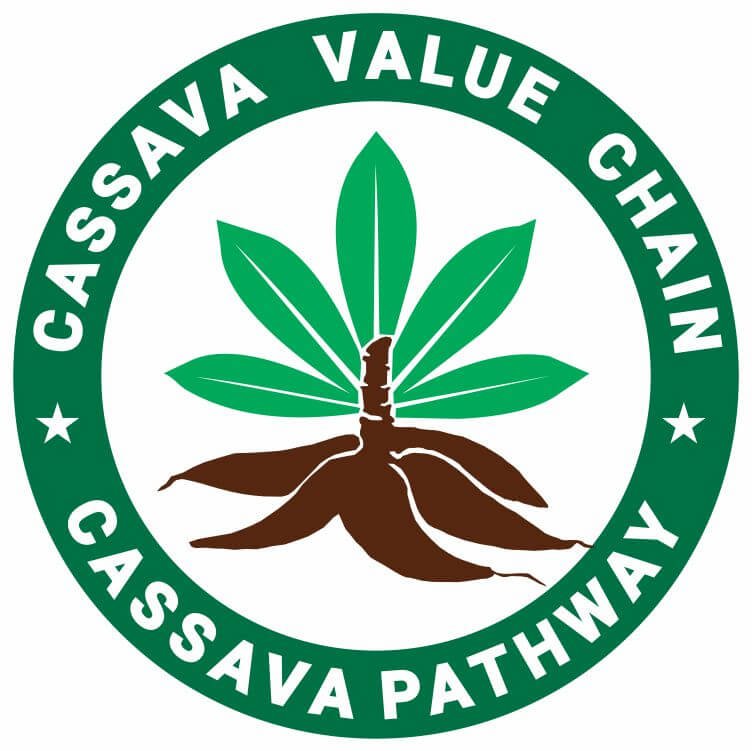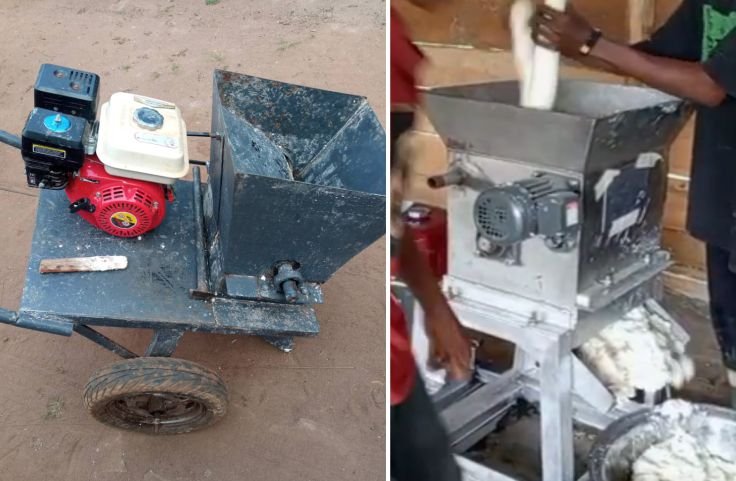The cassava grinding machine plays a vital role in turning raw cassava roots into usable food products. Knowing the right machine helps improve processing speed, safety, and final product quality.
As a cassava processor, you already know how much the grinding stage can affect the outcome.
It’s not just another step; it shapes the texture, usability, and quality of your end products.
You might be into the production of flour, starch, or fermented paste; how well your cassava is ground matters.
A well-chosen grinding machine helps reduce waste, improve consistency, and speed up processing.
It also plays a big role in how smoothly other steps, like drying or pressing, go afterward.
From small farms to industrial plants, grinding makes a difference in output and shelf life.
This guide will walk you through the different types of cassava grinding machines, explain how they work, and help you choose the one that fits your needs.
If you’re serious about boosting productivity, this is where your attention should be.
Table of Contents
- What is a Cassava Grinding Machine?
- How and Why Grinding Is a Key Step in Cassava Processing
- Types of Cassava Grinding Machines
- Choosing the Right Cassava Grinding Machine
- Maintenance and Safety Tips
- The Environmental Impact of Cassava Grinding
- Innovations in Cassava Grinding Technology
- Frequently Asked Questions
- Conclusion
What is a Cassava Grinding Machine?
A cassava grinding machine is a mechanical device used to crush peeled cassava roots into a smooth, wet paste.
It plays a key role in the production of fufu, cassava flour, and starch.
Unlike chippers or graters that produce slices or coarse mash, the grinder breaks down the cassava to a finer consistency using high-speed rotating blades or grinding stones.
Most machines are powered by electric motors or fuel engines, making them suitable for both small-scale and industrial processing.
Related: Maintenance Tips for Your Cassava Dewatering Machine
How and Why Grinding Is a Key Step in Cassava Processing
Cassava grinding does more than break down the tuber. It prepares the root for every step that follows and plays a big role in food safety, quality, and final product yield.
Grinding Helps Remove Cyanide from Raw Cassava
When you grind cassava, you’re helping release harmful cyanide compounds found in raw roots.
These toxins stay trapped unless the cell structure is broken.
Grinding tears the tuber open, allowing these compounds to escape so they can be washed or fermented out.
This step is critical to make cassava safe to eat and sell. Skipping or doing it poorly can leave harmful residues behind, especially in bitter cassava varieties.
Grinding Increases Surface Area for Faster Processing
Once cassava is ground, its exposed surface lets water, air, and heat reach more of the root.
This helps speed up drying, fermentation, and other follow-up steps.
It’s a major advantage when producing cassava flour or dough.
A smooth, even grind leads to better texture and moisture control, especially in products like fufu, lafun, or tapioca.
With more surface area, everything works faster and more evenly.
Grinding Supports Large and Small-Scale Efficiency
Whether you’re running a local mill or working from your backyard, grinding makes your cassava process smoother.
Machine grinders can process large batches quickly, cutting down labor and saving time.
Smaller operations can still benefit from manual or electric graters that fit local budgets and space.
Grinding cuts across scale. No matter your setup, it helps you keep quality high and work consistently from start to finish.
Best Cassava Processing Equipment Manufacturers
Multi-Function Cassava Processing Units
Types of cassava sieving machines
Types of Cassava Grinding Machines
Cassava grinding machines support different stages of cassava processing.
Choosing the right type helps improve output, save time, and produce cassava flour, starch, or paste that meets your target needs.
Cassava Grater
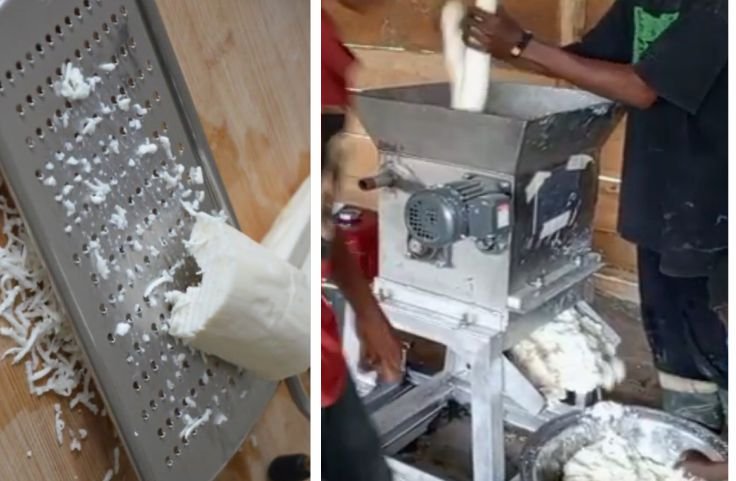
A cassava grater is used to shred fresh cassava roots into fine, moist pulp.
It’s available in different forms, from handheld metal graters and food processors to larger motorized machines for small to medium-scale processing.
The manual version is simple. You rub peeled cassava against a metal sheet with sharp teeth.
The pulp collects at the back, ready for pressing, fermenting, or drying. This method is common in home kitchens and for low-volume use.
The motorized cassava grater, on the other hand, uses an electric or fuel-powered motor to spin a grating drum at high speed.
You feed peeled cassava into a hopper, and the rotating drum shreds it into pulp in seconds. It’s much faster and more efficient than manual grading.
This version is ideal for community processors or small businesses making products like fufu, gari, or cassava mash in bulk.
Both types help break down the cell walls of the tubers, releasing starch and making it easier to remove cyanide.
They’re also easy to clean and maintain, helping you keep your work safe, steady, and efficient.
Cassava Rasper
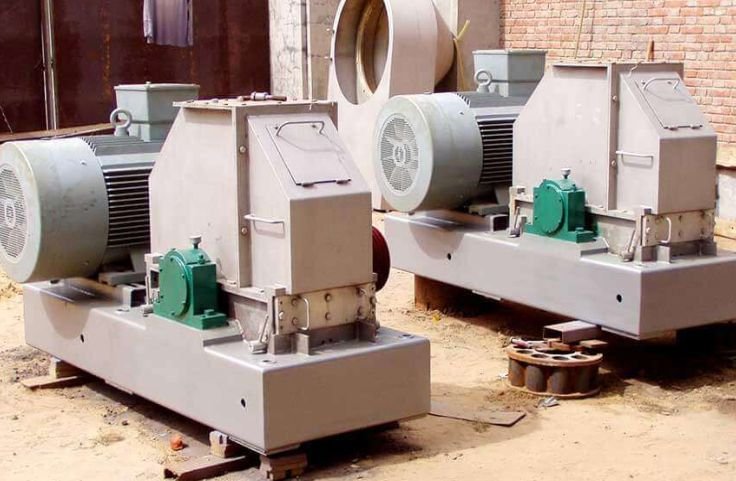
A cassava rasper is built for heavier grinding. It works like a grater but handles bigger batches and gives you a finer, more uniform pulp.
The rasper uses a fast-spinning drum with metal teeth to crush the cassava into a soft mash.
This mash is perfect for starch production, where smoothness and full extraction matter.
If you’re handling larger loads or aiming to produce commercial-grade starch or paste, this machine helps you speed up work without losing quality.
Its strong frame and high output make it ideal for factories or community-scale operations that process cassava daily.
Cassava Hammer Mill
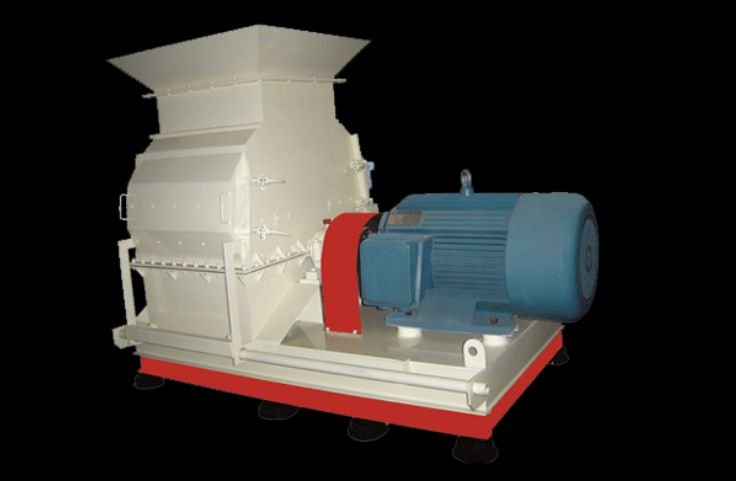
The cassava hammer mill is used for dry grinding. After cassava has been peeled, soaked, and dried, this machine breaks it into powder using small hammers that spin at high speed.
You can use it to make cassava flour, which works well in baking or industrial food production.
The hammer mill supports bulk processing and delivers a consistent texture, which helps during packaging or mixing.
If your goal is flour for commercial or home use, this machine gives you both quantity and quality.
It’s also a reliable choice when you’re working with pressed cassava cakes or chips.
Cassava Pulverizer
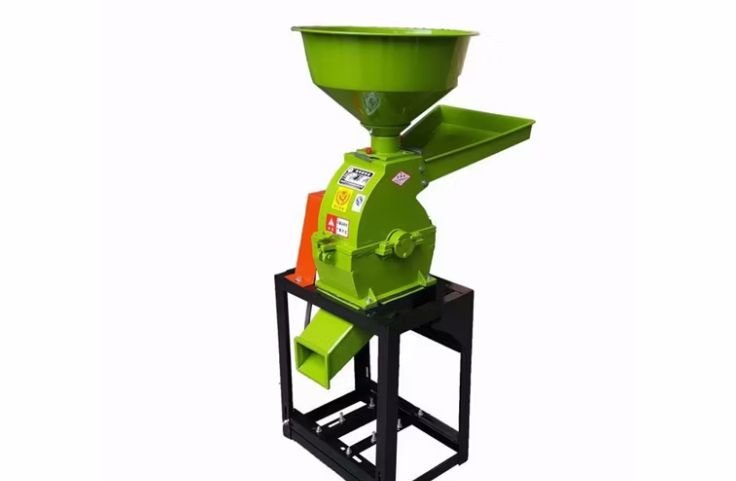
A cassava pulverizer helps when you want an extra-fine output.
It’s similar to the hammer mill but goes further by grinding dried cassava into ultra-fine powder or starch.
This machine is common in advanced food processing setups where fine texture is required for pastries, baby food, or other sensitive recipes.
It works well with dried tubers or pressed cassava cake and gives you smooth, dust-like flour.
If you’re targeting high-value food markets, the pulverizer is a smart step in your cassava line.
It’s also easy to integrate with sieving systems for better quality control.
Cassava Milling Machine
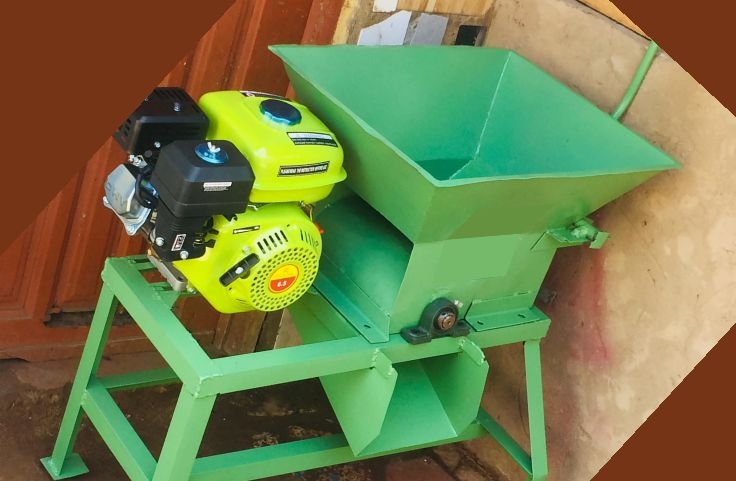
The cassava milling machine is a multi-purpose grinder that handles both wet and dry processing.
It can grind fresh cassava into mash or turn dried roots into flour, depending on how it’s set up.
This flexibility makes it useful in larger processing centers that handle different cassava products.
You can use it for fufu paste, gari base, or flour, all in one machine. It reduces the need for multiple tools and saves space.
If your work involves handling a mix of fresh and dry cassava, this machine helps streamline the process while keeping output consistent.
Choosing the Right Cassava Grinding Machine
Choosing the right cassava grinding machine depends on your processing goals, available power source, and the kind of output you want.
Making the right choice saves time and helps you avoid waste.
Consider the Scale of Your Operation
If you process cassava at home, a manual or small electric grater can work well.
For larger batches or business use, look for a stronger machine that handles larger quantities.
Big machines reduce workload and process cassava faster, making them ideal for factories, cooperatives, or growing local food businesses.
Match the Machine to Your Final Product
Your end product matters when choosing a machine. Some machines grind for soft pastes used in fufu or dough.
Others give a coarse or fine finish for flour or starch.
Pick a machine that fits your product goal so you don’t lose time correcting texture later.
Choose a Suitable Power Source
Your power source should match the machine. Electric machines are fast but need steady power.
Diesel models work better where electricity is limited. Manual machines are cheap to run and useful in off-grid areas.
Choose what fits your energy setup and keeps your work running without interruption.
Think About Maintenance and Spare Parts
Machines need care. Go for models with easy-to-find parts and low maintenance needs.
A machine that is hard to fix can delay your work. Ask around or check for support in your area.
A machine that’s easy to clean and maintain gives you fewer problems down the line.
Maintenance and Safety Tips
Keeping your cassava grinding machine in good shape starts with simple habits.
Proper care not only makes your machine last longer but also helps keep your processing safe and smooth.
Clean Every Part After Use
Whether you use a grater, rasper, mill, pulverizer, or multipurpose milling machine, cleaning after each session is key.
Cassava residues can build up fast, especially in machines that handle wet mash.
Letting moisture or pulp sit too long can attract bacteria and rust parts over time.
Clean out all chambers, wipe down surfaces, and allow the machine to dry before storing.
Sharpen or Replace Blades When Needed
For machines with blades, like graters and raspers, sharp edges matter. Dull blades stress the motor and reduce grinding efficiency.
Sharpen or replace them based on how often you use the machine.
Blunt blades can also leave your cassava too coarse, affecting the quality of flour, fufu, or starch.
Maintain Hammer and Disc Parts
If you’re using a hammer mill or pulverizer, check the hammers or discs regularly for wear.
These machines don’t have blades, but the moving parts still take a beating from constant use.
Loose or damaged parts can affect output and cause jams. Replace worn components early to avoid expensive repairs later.
Check Screws, Seals, and Bearings
Machines that run frequently can loosen screws or wear out seals. Always inspect these parts during cleaning or weekly checks.
A small issue like a loose bolt can cause vibration or motor trouble. Keep the machine stable and tight so it runs smoothly.
For machines with bearings, lubricate them as advised in the user manual.
Use Proper Safety Gear
Grinding machines can be noisy, sharp, and messy. Always wear gloves to protect your hands from cuts or heat.
Use goggles or face shields to guard against splashes or flying particles.
If the machine is loud, ear protection helps you work longer without stress.
Avoid Overloading the Machine
Every machine has its limit. Forcing too much cassava into it slows performance and may damage the motor or internal parts.
Feed small batches and let the machine work at its own pace.
Overloading shortens the machine’s life and increases repair costs.
Watch the Power Supply
For electric models, always use a steady power source. Power surges or unstable voltage can burn the motor.
If you’re in an area with inconsistent electricity, consider using a stabilizer or switch to diesel or manual models.
Never run electric machines in wet conditions to avoid shock or damage.
Store in a Dry, Covered Place
After cleaning, store the machine where rain, dust, or pests won’t reach it. Moisture causes rust, especially in metal parts.
Cover the machine with a cloth or plastic and keep it off bare floors when not in use.
The Environmental Impact of Cassava Grinding
Cassava grinding supports food production, but also affects the environment.
From waste handling to energy use, how you manage your process can either help or harm the land and air around you.
Manage Waste from Cassava Grinding
When grinding cassava, you deal with a lot of waste, mainly peels, fibers, and pulp.
If this organic waste piles up untreated, it can pollute the air and nearby water.
Some of it releases gases like methane when it breaks down.
You can reduce this impact by turning waste into compost, animal feed, or biogas.
Finding smart ways to reuse or dispose of leftovers helps you keep your area clean and supports healthier farming systems.
Reduce Energy Use During Processing
Cassava grinding machines need power to run. Many use electricity or diesel, which adds to greenhouse gas emissions.
If you rely on this kind of energy every day, it adds up fast. Switching to solar panels or other renewable sources can cut that impact.
You can also look for machines that use less energy or have standby features.
When your equipment works efficiently, you save fuel and lower your carbon footprint at the same time.
Choose Eco-Friendly Machines and Methods
Some newer cassava grinders are designed to use less power and generate less waste.
These machines support cleaner processing without reducing output.
When you choose tools that work efficiently and cleanly, you’re not only protecting the land, you’re building a better setup for the long run.
If you combine this with good waste practices and smart energy choices, your cassava grinding process becomes more sustainable.
This benefits your farm, your community, and the environment around you.
Innovations in Cassava Grinding Technology
Modern cassava grinding technology has advanced to meet the needs of efficiency, sustainability, and reduced labor.
One major shift is the use of automation, with machines now equipped with sensors and controls that improve product consistency and reduce human error.
These upgrades streamline processing and increase productivity. Energy-efficient designs, such as machines with variable frequency drives, help cut power use and lower costs.
More processors are turning to solar energy to reduce their carbon footprint.
New machines are also made with sustainable materials that boost durability and support eco-friendly practices.
Some designs reduce waste by reusing cassava by-products like peels for other uses, promoting a circular economy.
Improved machine designs make operation and maintenance easier, even for workers with limited technical skills.
These innovations are helping both large and small processors upgrade their operations while keeping environmental and economic concerns in mind.
Cassava grinding is becoming smarter, cleaner, and more accessible.
Frequently Asked Questions
What is the difference between a cassava grater and a rasper?
A cassava grater shreds cassava into pulp, while a rasper is stronger and breaks tubers down further, mainly for starch and large-scale processing.
Can cassava grinding machines process both wet and dry cassava?
Yes, some machines are built to handle both wet and dry cassava, especially multipurpose milling machines used for flour, dough, or fermented paste production.
Are manual cassava grinders still used today?
Yes, manual grinders are still used in small-scale or household settings where electricity is limited or not available, and budgets are tight.
What type of grinding machine is best for cassava flour?
Hammer mills or pulverizers are best for cassava flour since they grind dried cassava into fine, smooth powder ideal for commercial or home use.
Conclusion
Cassava grinding machines continue to evolve, offering practical solutions for processors at every scale.
From manual graters to automated systems with energy-saving features, the right machine depends on your processing needs, power availability, and end-product goals.
Innovations in grinding technology not only improve product quality and reduce waste but also promote sustainability through better energy use and material choices.
With machines becoming easier to maintain and operate, even small businesses can take advantage of modern processing tools.
Whether you’re making flour, fufu, or starch, investing in the right cassava grinding machine ensures better results, longer machine life, and a smoother workflow.
References
Good Way: Cassava Grinding Machine
